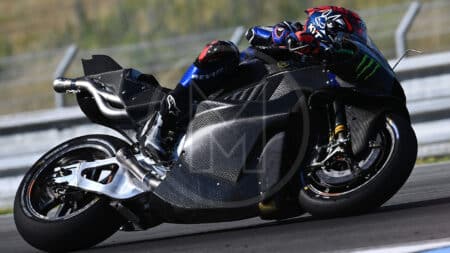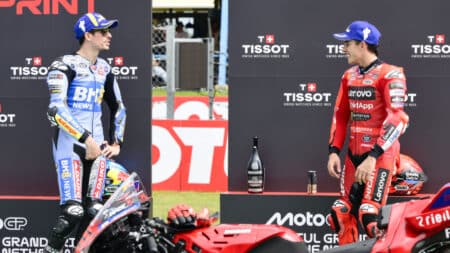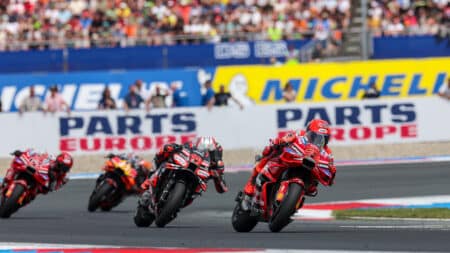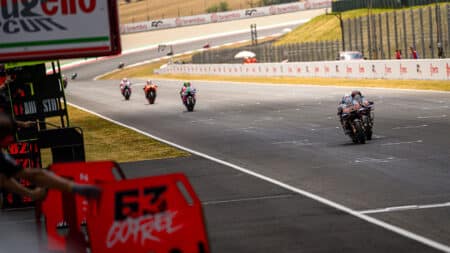
Exclusive: Yamaha’s V4 MotoGP bike seen for the first time!
After months of waiting, we’ve managed to get the first photos of Yamaha’s all-new MotoGP bike, designed to revive the factory’s fortunes in MotoGP
Two weeks from now MotoGP’s Grand Prix Commission sit downs in Madrid to decide the future of Grand Prix racing.
The December 17 meeting will finally rubber stamp the biggest regulations shake-up since the four-strokes arrived a dozen years ago, which the manufacturers and Dorna have been arguing over for what seems like forever. As always, they hold opposite positions: Dorna want low-cost, TV-friendly entertainment, the factories want an R&D-friendly technology race.
The GPC – made up of one representative each from Dorna, the MSMA, the FIM and teams association IRTA – will decide on plans to reduce performance, increase fuel capacity and essentially freeze electronics R&D.

Fuel capacity probably sounds like the most boring of these subjects but, please bear with me, it isn’t. There’ve been a lot of broken bones and broken bikes due to MotoGP’s ever-shrinking fuel tanks.
Back in the final days of the two-stroke premier class, 500s had 32-litre fuel tanks. Factory MotoGP bikes now get just 20 litres, which means they must consume 25 per cent less fuel than a World Superbike machine if they are to see the chequered flag. Daft, eh? You’d think it would be the other way around: full-on race bikes using more fuel than hopped-up road bikes.
Reducing fuel consumption was initially a (frankly ridiculous) nod to the green movement. Then the manufacturers realised they could learn a lot about lean-burn engines, so they asked for even smaller fuel tanks, to push their engineers even harder.
But there’s been a major downside to this. When they are forced to save a few drops of fuel, literally at every turn, engineers can’t help but make the bikes more dangerous. That’s why in recent years there’s been a huge increase in corner-entry highsides, which hurt riders every bit as much as the corner-exit highsides that smashed up so many riders in the wildest days of 500s.
Factory MotoGP engineers tell me that they try to save 10cc of fuel every lap – a very significant quarter of a litre over a 25 lap race – during downshifting by shutting off the fuel when the throttle is closed.
“Completely shutting off the fuel during downshifts gives too much engine-braking which brings big problems,” explains MotoGP’s Director of Technology Corrado Cecchinelli, Dorna’s man in charge of rule-making. “To have the engine-braking you want, you need fuel. By going very lean you have erratic combustion which can mean a different braking character at every corner, which is what catches riders out.”
Over the years I’ve blamed MotoGP’s plague of corner-entry highsides entirely on Bridgestone, so I owe the company a partial apology. It’s difficult to know exactly how to apportion the blame, but it’s certainly shared by Bridgestone’s super-stiff, hard-to-warm-up rear slicks (now, thankfully, a thing of the past) and the 20-litre fuel regulation. In others words, all riders who’ve suffered this kind of crash – few, if any, have escaped the fate – deserve an apology from the MSMA.
Of course, riders suffering physical injury and worse for the good of technological development is nothing new. Back in the 1960s and ‘70s dozens and dozens of riders died when their two-stroke engines seized, locked the rear wheel and hurled them to the ground. Eventually, metallurgy, lubrication and so on improved to the point where two-strokes rarely seized.
It was the same in the early years of hi-tech electronics. At Cadwell Park in 1988 Keith Huewen’s Bimota YB4 – running the latest but half-baked Weber/Magneti Marelli fuel-injection system – suddenly slowed when the injection went AWOL, cutting the engine. Kenny Irons was killed when he struck the rear of Huewen’s machine.
More recently I’ve lost count of the horror stories told to me by riders who’ve been badly hurt by traction control systems that, all of a sudden, have decided not to control the traction, or by engine-braking systems that have refused to turn off the gas when the rider shuts the throttle. Can you imagine how that must feel?

Engineers learn from disasters such as these and that’s why racing improves the breed. Obviously, the manufacturers benefit, but we, the riders of road bikes, are the final beneficiaries, so we all owe these riders a huge debt of thanks.
So, how much fuel will MotoGP bikes get from 2016? Pre-Madrid meeting leaks suggest that fuel tanks will grow to 22 litres, halfway between the current 20-litre minimum and the 24 litres enjoyed by Open bikes. The increase is essential because the mandatory-from-2016 control ECU won’t feature fuel-saving software.
And what of reducing performance and freezing electronics development?
Despite the fact that the fastest MotoGP bikes nudged 225mph at Mugello last June, the factories are against reducing performance and seem likely to win this particular battle with Dorna. Most factories hate the idea of an rpm limit, which they insist would force them into hugely expensive engine redesigns.
I’m not an engineer, so I thought this was nonsense, but it’s not. Next year the Moto3 rpm limit decreases from 14,000rpm to 13,500rpm and KTM are indeed designing a new engine, with a narrower bore which will be more efficient at the lower rev ceiling.

Air restrictors had also been mooted to reduce top-end performance, but Cecchinelli hates restrictors because they’re also expensive to develop and because they benefit manufacturers with car-racing experience. (ie Honda, but also now Ducati, who have Audi know-how.) So, enjoy the full-on 1000s while you can, but expect a serious performance reduction at the end of the decade.
Although many people (that’s Dorna, most riders and fans, including myself) want a major reduction in rider aids, the much-hyped 2016 control ECU won’t so much reduce electronics performance as freeze it. The system will be based on the current control ECU used by Open teams and it will work like this: the factories present Dorna’s technicians with a logic diagram of any function they want added to the existing control ECU. If Dorna agree that the function is simple enough to be used by smaller teams who don’t employ a dozen electronics boffins, they will translate the logic blocks into computer language, then Magneti Marelli will physically write the software. No factory will be allowed to offer lines of their own software to load into the ECU.
The increase in fuel allowance and the freezing of rider aids are both steps in the right direction on a journey down a very long road, with Dorna and the MSMA bickering all the way.

After months of waiting, we’ve managed to get the first photos of Yamaha’s all-new MotoGP bike, designed to revive the factory’s fortunes in MotoGP

Alex Márquez has finished runner-up to older brother Marc in 13 of 20 MotoGP race starts this season and after last weekend's Dutch TT Grand Prix it seems some impatience is brewing with the sibling dynamic

Marc Márquez woke up on Sunday morning unsure he could race, following two big crashes in practice for the 2025 Dutch Grand Prix. And yet he continued to steamroll his MotoGP rivals and the record books

Mugello has been the home of Rossi mania and lately a fortress for Ducati… but the Italian circuit is chiefly synonymous for the biggest rush in MotoGP racing